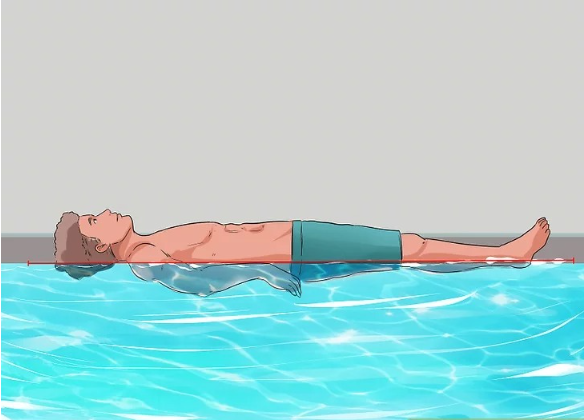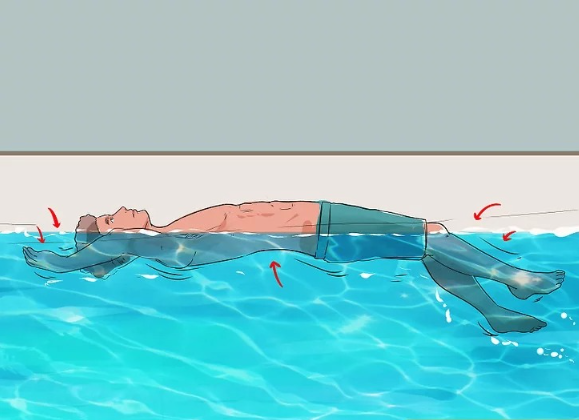Falling into deep water unexpectedly can be a terrifying experience, especially if you don’t know how to swim. Panic sets in, your instincts tell you to struggle, and before you know it, you’re exhausted and in real danger. However, survival in such a situation is entirely possible if you remain calm and follow a set of simple but life-saving steps.
According to Dr. Nash and his team of researchers, the key to survival is overcoming fear instincts and following five crucial steps. These steps are designed to help anyone—regardless of swimming ability—stay afloat, breathe, and increase their chances of rescue. Let’s dive into these life-saving techniques.
1. Stay Calm and Relax to Achieve Natural Buoyancy

The first and most critical step is to fight the urge to struggle. Many people instinctively flail their arms and legs in a desperate attempt to stay above water. However, this only wastes energy and causes faster exhaustion.
Instead, take a deep breath and allow your body to relax. When you stop panicking, your body will naturally float closer to the water’s surface. The human body is slightly less dense than water, meaning that if you remain still, you can achieve buoyancy without much effort.
2. Tilt Your Head Back to Keep Your Airway Clear
Once you’ve calmed yourself and started floating, you need to ensure that you can breathe. The best way to do this is to tilt your head back, keeping your face above the water.
Try not to move too much, as sudden movements can make you sink slightly. If you feel yourself going under, resist the urge to panic—simply take a deep breath, relax your muscles, and allow yourself to rise again.
Video : How to Survive if You Fall in Water – Prevent Yourself From Drowning – Survival Techniques
3. Breathe Slowly and Avoid Inhaling Water
Now that your nose and mouth are above water, it’s time to focus on breathing. Many people instinctively gasp for air, but this can lead to choking if water splashes into your mouth. Instead, practice controlled breathing:
- Exhale slowly through your nose to clear any water that may have entered.
- Inhale through your mouth in a controlled manner.
- If a wave covers your face, hold your breath momentarily, then resume normal breathing.
Even experienced swimmers can struggle if they inhale water, so maintaining steady breathing is crucial for survival.
4. Move Your Arms and Legs Gently to Stay Afloat
At this point, you should be floating on the water’s surface and breathing steadily. The next step is to use gentle, controlled movements to maintain your position.
- Use slow arm movements: Move your arms in a sweeping motion, like you’re making small circles in the water. This will help you stay afloat without expending too much energy.
- Legs should remain still if you don’t know how to kick properly: If you’re unsure how to tread water, keeping your legs still is often better than kicking randomly. Let them sink slightly while focusing on keeping your upper body above water.
The key here is to avoid frantic movements—slow and deliberate strokes will keep you afloat much longer.

5. Look for Rescue Opportunities
Once you’ve gained control of your breathing and movements, your next priority is finding a way to safety.
- Scan your surroundings – Look for anything floating that you can grab onto, such as a buoy, a log, or even a piece of debris. Holding onto something will help you conserve energy.
- Check your distance from the shore – If you can see land, assess whether it’s possible to move toward it using slow, steady movements.
- Signal for help – If there are people nearby, shout for help. However, conserve energy by calling out only when necessary.
If you’re caught in a strong current, do not try to swim directly against it—this will only tire you out. Instead, swim diagonally at an angle to gradually move out of the current’s pull.
What to Do If You See Someone Drowning
If you witness someone struggling in deep water, it’s important to act quickly but safely. Jumping in to rescue them may seem like the right thing to do, but unless you’re a trained rescuer, it could put both of you at risk.
Instead, follow these steps:
- Shout instructions – Encourage the person to follow the survival steps above. Remind them to relax, tilt their head back, and float.
- Find a flotation device – If possible, throw a life jacket, a rope, or any floating object they can grab onto.
- Call emergency services – Immediately contact your local emergency number and provide details of the situation.
Video : How to get over fear of water – Feel safe on the deep end
Why Staying Calm is the Key to Survival
Many drowning incidents occur not because the victim physically sinks, but because they panic and exhaust themselves. Learning how to override panic instincts and follow a survival routine can mean the difference between life and death.
Dr. Nash explains:
“Whether you’re planning a vacation, taking a walk near a river, or going for a swim, knowing how to stay safe in water is crucial. These simple survival techniques can save your life or someone else’s.”
Final Thoughts
Surviving a fall into deep water without knowing how to swim is possible—but only if you remain calm and follow the right steps. By floating, maintaining steady breathing, and making slow movements, you can conserve energy and increase your chances of rescue.
Now that you know these survival strategies, share them with your friends and family. You never know when this knowledge might save a life!
Entitled Neighbor Built a Garage in My Garden – I Showed Him Why You Shouldn’t Mess With a Single Mother

My new start turned into a nightmare when my neighbor, Mr. Johnson, brazenly built a garage on my property. With the help of determined friends and a few sledgehammers, I decided to reclaim my garden and teach him a lesson he wouldn’t forget.
My name is Cynthia. I’m 42 years old and a single mother with two children. A few months ago, we moved into a new house with a lovely garden. It was supposed to be a fresh start for us. Little did I know, trouble was waiting next door.

Middle-aged woman playing with her children | Source: Midjourney
On the first day, as we unpacked boxes, our neighbor, Mr. Johnson, came over. He was a tall, burly man with a gruff voice.
“Hello, I’m Mr. Johnson,” he said without a smile. “I’ve got plans to build a garage, and half of it will be on your land. The previous owner agreed.”
I was taken aback. “I’m sorry, Mr. Johnson, but I’m the new owner, and I don’t give my consent,” I replied firmly.

A middle-aged man | Source: Pexels
Mr. Johnson’s face turned red. “You don’t understand. It’s already agreed upon. I have documents.”
“I understand perfectly,” I said, standing my ground. “But this is my property now, and I won’t allow it.”
Over the next few days, Mr. Johnson came over multiple times, documents in hand, trying to convince me. Each time, I said no.

A middle-aged man with the documents | Source: Midjourney
One weekend, I took my children to visit my mother. We spent a lovely time with her, enjoying the change of scenery and catching up. My mother lives a couple of hours away, so it was a nice break for all of us.
When we returned, I couldn’t believe my eyes. There, in our garden, was a fully built garage. It took up almost the entire space.
“How could he?” I gasped. My children looked up at me with wide eyes.

A shocked woman | Source: Pexels
“Mom, what are we going to do?” my daughter asked, her voice tinged with worry.
“We’ll handle this,” I said, my resolve hardening. I thought about writing to a lawyer but decided to take matters into my own hands first.
I walked around the garage, inspecting every inch. It was solidly built, but it had no place in my garden. My frustration grew with each step.

A white garage with a car | Source: Pexels
I sat down with my kids and explained the situation. “We need to make sure we get our garden back. It’s not fair for someone to take what’s ours.”
My son looked up at me with determination. “We can do it, Mom!”
That night, I called a few friends. They were more than willing to help dismantle the unauthorized garage.

Middle-aged woman calling her friends | Source: Midjourney
“Are you sure about this, Cynthia?” my friend Lisa asked over the phone.
“Yes, Lisa. He crossed the line. We have to do this,” I replied.
I also called Mark, a strong and handy friend, and Jess, who was always up for a challenge. They both agreed to help without hesitation.

A ripped man talking on his phone | Source: Midjourney
“Count me in, Cynthia,” Mark said. “This guy needs to learn a lesson.”
“I’ll bring the tools,” Jess added. “We’ll take it apart piece by piece.”
We spent some time planning. We needed to be careful not to damage any of my property while dismantling the garage. We decided on a step-by-step approach, ensuring that every piece was removed methodically.

Planning the perfect plan | Source: Midjourney
We gathered at my house just as darkness fell, armed with sledgehammers, crowbars, and flashlights. My friends, Lisa, Mark, and Jess, were ready to help me reclaim my garden. The air was thick with anticipation.
“Ready?” I asked, gripping my crowbar tightly.
“Ready,” Lisa replied with a determined nod.

Determined middle-aged woman | Source: Midjourney
We moved silently into the garden. The garage loomed before us, a symbol of Mr. Johnson’s audacity. We set to work, our movements careful and deliberate. Each removal of a nail or plank felt like a step toward justice.
“Start with the roof,” Mark suggested, his voice barely a whisper. “It’ll be easier to take apart the walls once that’s off.”
Jess climbed up a ladder and began to gently pry off shingles. “This is for your garden, Cynthia,” she said.

A woman near a ladder | Source: Midjourney
“Thanks, Jess. Let’s keep at it,” I encouraged, carefully removing a panel.
The hours passed quietly. We worked in sync, fueled by a shared sense of righting a wrong. The physical effort was exhausting, but it felt empowering. We whispered words of encouragement to each other, the night providing a cloak of secrecy.
Lisa handed me a board she’d removed. “Here, stack this neatly. We don’t want to damage anything.”

A woman holding a board | Source: Midjourney
“Got it,” I said, placing it on the growing pile.
By dawn, the garage was nothing but a pile of neatly stacked rubble. We stood back, panting and sweaty, but deeply satisfied.
“Well done, team,” Mark said, giving me a pat on the back.
“Thank you all. I couldn’t have done this without you,” I replied, grateful for their support.

A part of the materials stacked on the driveway | Source: Midjourney
The next morning, Mr. Johnson stormed over. His face was red with fury. “What have you done?” he bellowed. “This is vandalism! Trespassing! You’ll pay for this!”
I remained calm, standing my ground. “Mr. Johnson, you built on my land without permission. I have documented everything, including photos and videos of your illegal construction and our careful dismantling.”
“You… you can’t do this!” he sputtered, eyes wide with anger.

An angry middle-aged man | Source: Pexels
“I already did,” I said, pointing to the clear boundary markers. “You ignored these.”
Mr. Johnson’s bluster faded as he saw the evidence and my unwavering resolve. He muttered something under his breath and retreated to his house, slamming the door behind him.
Despite our victory, I knew the situation wasn’t entirely resolved. I decided to consult a lawyer to ensure all my actions were within legal bounds and to explore any additional steps I could take.

A lawyer viewing papers | Source: Pexels
The lawyer confirmed that I was in the right. My documentation and photos provided solid evidence. Knowing this gave me peace of mind. I felt confident that if Mr. Johnson persisted, I had the law on my side.
In the following days, I noticed a change in Mr. Johnson. His confrontational visits dwindled. He seemed quieter, less aggressive. One day, to my surprise, he came over, looking apologetic.

An apologetic middle-aged man | Source: Pexels
“Cynthia, I’m sorry,” he said, his voice softer than I’d ever heard it. “The previous owner gave me verbal permission, but I should have respected your ownership.”
I was taken aback. “Thank you, Mr. Johnson. I appreciate your apology.”
“I’d like to make things right,” he continued. “I’ll rebuild the garage entirely on my property. And if you need any help with repairs around your house, I’m here to assist.”

An apologetic middle-aged man | Source: Midjourney
We reached an agreement. It wasn’t an immediate friendship, but it was a start to a more civil relationship. I had reclaimed my garden and gained a measure of respect from Mr. Johnson.
As the days went by, we began to exchange pleasantries. He even helped me fix a few things around the house. The experience taught me a valuable lesson in standing up for myself and my rights.

A happy woman | Source: Pexels
Reflecting on the ordeal, I felt proud of how I handled the situation. I didn’t just get my garden back; I gained respect and a better understanding of my own strength and resilience. I knew that, no matter what, I could stand up for what was right.
Sweet Lady Feeds Local Kids for Free – When a Neighbor Tried to Kick Her Out, the Unbelievable Happened
Kind Mrs. Johnson is setting up her usual Saturday lunch for the local kids when a grumpy neighbor confronts her. The situation escalates quickly, ending with the sweet older lady in tears. But the grouchy neighbor soon realizes his bullying won’t be tolerated!
I have to share something that happened in my neighborhood last Saturday. It involves a sweet lady, some local kids, and a grumpy neighbor. The ending is unbelievable!

Children playing on a field | Source: MidJourney
There’s a football field near our house where the local kids play on weekends. Mrs. Johnson, who lives down the street, has been making hot dogs and other goodies so the kids can stay and play longer without having to go home hungry.
It seems ridiculous that anyone would have an issue with an older lady doing a good deed, but that’s exactly what happened.
Mrs. Johnson is a real gem. She’s probably in her late 60’s and has the kindest smile. Unfortunately, she’s a bit lonely. I think her kids live far away, and she lost her husband a few years back. This little tradition of hers, feeding the kids, seems to bring her so much joy.

Older woman preparing hot dogs | Source: MidJourney
And the kids love it, too. Every Saturday, they rush over to Mrs. Johnson’s table, laughing and chatting, grabbing their hot dogs, and thanking her.
It’s a heartwarming sight, which is why last Saturday’s events were so shocking.
Mrs. Johnson was setting up her table as usual when Mr. Davis, the grumpy neighbor from across the street, stormed out of his house, ready for a fight. I was astonished to see him beeline over to Mrs. Johnson.



Leave a Reply